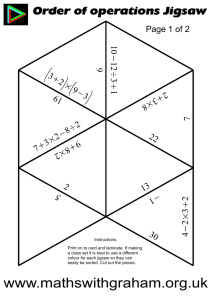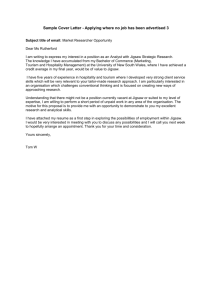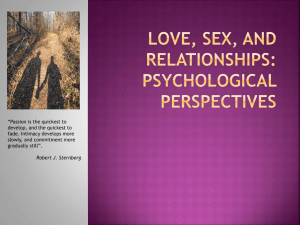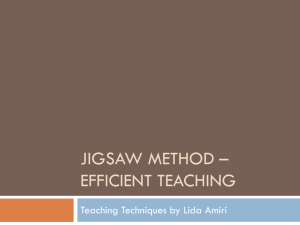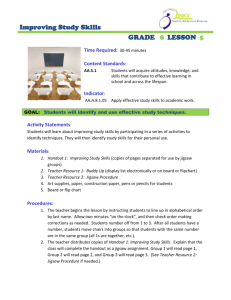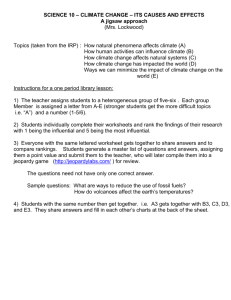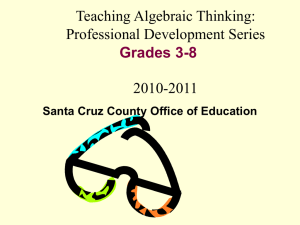Patel Center for Global Solutions
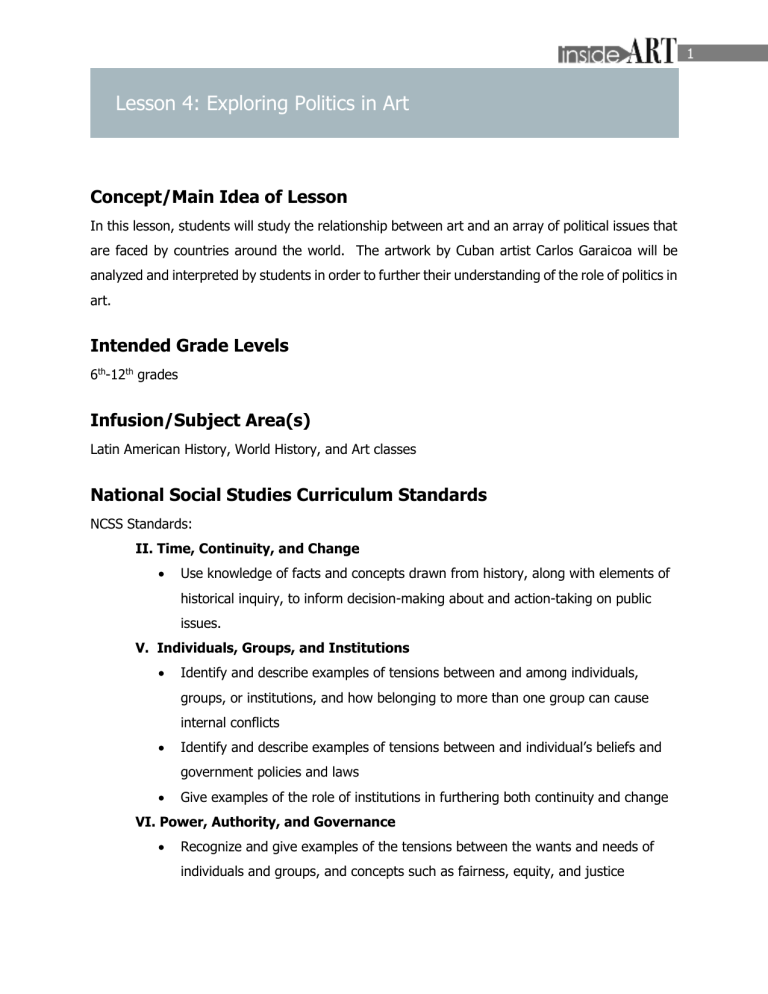
Inside Art 1
Lesson 4: Exploring Politics in Art
Concept/Main Idea of Lesson
In this lesson, students will study the relationship between art and an array of political issues that are faced by countries around the world. The artwork by Cuban artist Carlos Garaicoa will be analyzed and interpreted by students in order to further their understanding of the role of politics in art.
Intended Grade Levels
6 th -12 th grades
Infusion/Subject Area(s)
Latin American History, World History, and Art classes
National Social Studies Curriculum Standards
NCSS Standards:
II. Time, Continuity, and Change
Use knowledge of facts and concepts drawn from history, along with elements of historical inquiry, to inform decision-making about and action-taking on public issues.
V. Individuals, Groups, and Institutions
Identify and describe examples of tensions between and among individuals, groups, or institutions, and how belonging to more than one group can cause internal conflicts
Identify and describe examples of tensions between and individual’s beliefs and government policies and laws
Give examples of the role of institutions in furthering both continuity and change
VI. Power, Authority, and Governance
Recognize and give examples of the tensions between the wants and needs of individuals and groups, and concepts such as fairness, equity, and justice
Inside Art 2
Florida Standards for the Arts:
Skills and Techniques
The student understands and applies media, techniques, and processes.
(VA.A.1.4)
Aesthetic and Critical Analysis
The student assesses, evaluates, and responds to the characteristics of works of art. (VA.D.1.4)
Applications to Life
The student makes connections between the visual arts, other disciplines, and the real world. (VA.E.1.4)
Common Core:
LACC.1112.RI.1.1: Cite strong and thorough textual evidence to support analysis of what the text says explicitly as well as inferences drawn from the text, including determining where the text leaves matters uncertain.
LACC.1112.RI.2.4: Determine the meaning of words and phrases as they are used in a text, including figurative, connotative, and technical meanings.
LACC.1112.L.3.5: Demonstrate understanding of figurative language, word relationships, and nuances in word meanings.
LACC.1112.L.3.6: Acquire and use accurately general academic and domain-specific words and phrases, sufficient for reading, writing, speaking, and listening at the college and career readiness level.
CCSS.ELA-Literacy.RH.9-10.7: Integrate quantitative or technical analysis (e.g., charts, research data) with qualitative analysis in print or digital text.
I. Instructional Objective
Students will: a. describe, analyze, interpret and evaluate work by artist Carlos Garaicoa; b. c. d. participate in jigsaw cooperative learning activity; participate in a teacher-led discussion on the artwork; brainstorm other possible buildings/locations that could be considered “crown jewels.”
Inside Art 3
II. Learning Activities Sequence
a. Set Induction/Lesson Initiating Behavior: Students will study, analyze, and answer interpretation questions based on Carlos Garaicoa’s art work
Joyas de la
Corona (The Crown Jewels).
A slide handout, of Garaicoa’s piece
Joyas de la
Corona
, should be passed out for all students to see and analyze.
The following questions, based on Edmund Burke Feldman’s
Varieties of Visual
Experience
, should be completed by students.
DESCRIPTION - Identify the elements and materials included. Inventory what is presented. Be objective; avoid interpretation or evaluation.
Name and describe what you see - objects, shapes, colors, spaces etc.
Classify the elements - line, color, form and texture.
Identify how the work was made - materials and procedures involved.
Locate the title of work. Under normal circumstances, what meaning does the title have?
FORMAL ANALYSIS - How are things organized? How the elements relate to each other? What choices has the artist made?
How are things alike and different?
How are things placed relevant to one another (space)
Identify characteristics of the elements - e.g. elongated forms, intensity of colors, etc.
Analyze the compositional structure - e.g. balance, positive/negative relationships, unity, etc.
INTERPRETATION - In view of the evidence you have seen, what does the work mean?
Is there a problem the work seems involved with?
What is or is there a thematic nature of the work?
How did the artist use the elements of art and composition to achieve his
Inside Art 4 goals?
Why might the title
Crown Jewels
be considered a sarcastic or ironic commentary?
EVALUATION - How does this work rate, based on the above aesthetic merits?
What are the big questions you can ask about this work?
Consider originality or the ability of the artist to solve the problem he or she was dealing with.
Does the work communicate significant ideas, relate to the human condition, etc.? If not, does that diminish the work’s value to society?
What functions does the work serve?
Has he/she been successful in solving the problem or communicating the message or achieving the function of the work?
Original Version of Aesthetic Criticism Questions from: http://beach.ksu.edu/curricula/photo-curriculum/pdfs/aesthetic-criticism.pdf
NOTE: The above version has been slightly modified. b. Learning Activities: As a class, students will share their answers to the above questions. Next, students will take part in a jigsaw cooperative learning activity in which they will read about one of seven buildings found in
Las Joyas de la
Corona (The Crown Jewels).
The readings can be found on the following websites and those with multiple readings can be used interchangeably.
NOTE: There is no article for DGI due to lack of information on that particular site.
1.
Estadio de Chile
Chile's National Stadium: As Monument, as Memorial
http://www.drclas.harvard.edu/revista/articles/view/704
2.
Escuela de Mecánica de la Armada
Raw Nerves at a Museum of Argentina’s Dirty War
Inside Art 5 http://www.usnews.com/articles/news/world/2008/12/22/raw-nerves-ata-museum-of-argentinas-dirty-war.html
3.
Base Naval de Guantánamo
Guantanamo Bay history
http://www.cbc.ca/world/story/2009/01/22/f-gitmo.html
4.
Stasi
Piecing Together the Dark Legacy of East Germany’s Secret Police http://www.wired.com/politics/security/magazine/16-02/ff_stasi/
5.
KGB http://school.eb.com/eb/article-233708
6.
Pentagon Building www.worldbookonline.com
7.
Villa Marista
US Officials Ask Cuba to Release Jailed American http://abcnews.go.com/International/wirestory?id=9887448&page=1
8. DGI (Linea y A)
Jigsaw in 10 Easy Steps
Instructions modified from: http://www.jigsaw.org/steps.htm
The jigsaw classroom is very simple to use. If you're a teacher, just follow these steps:
1.
Break students into four groups (7 students per jigsaw group). Pre-assign groups if necessary. The groups should be diverse in terms of gender, ethnicity, race, and ability.
Inside Art 6
2.
Appoint one student from each group as the leader.
3.
Divide the day’s lesson. This particular lesson has been divided into 7 segments. (1) Estadio de Chile, (2) Escuela de Mecánica de la Armada, (3)
Base Naval de Guantánamo, (4)Stasi, (5) KGB, (6) Pentagon Building, and (7)
Villa Marista.
4.
Assign each student to learn one segment, making sure students have direct access only to their own segment.
5.
Give students time to read over their segment at least twice and become familiar with it. There is no need for them to memorize it.
6.
Form temporary "expert groups" by having one student from each jigsaw group join other students assigned to the same segment. Give students in these expert groups time to discuss the main points of their segment and to rehearse the presentations they will make to their jigsaw group.
7.
Bring the students back into their jigsaw groups.
8.
Ask each student to present her or his segment to the group. Encourage others in the group to ask questions for clarification.
9.
Float from group to group, observing the process. If any group is having trouble (e.g., a member is dominating or disruptive), make an appropriate intervention. Eventually, it's best for the group leader to handle this task.
Leaders can be trained by whispering an instruction on how to intervene, until the leader gets the hang of it.
10.
At the end of the session, give a quiz on the material so that students quickly come to realize that these sessions are not just fun and games but really count.
Inside Art 7 c. Closure: As a class, read the excerpt of an interview with Carlos Garaicoa regarding this particular piece of art. Allow students to an opportunity to express their thoughts on the artist’s point of view and their own.
III. Evaluation
Homework Assignment – Students will brainstorm and research another possible places from around the world, they would consider to be a possible “crown jewel," according to Garaicoa’s perspective. Students are to turn in a two-paragraph opinion statement detailing their chosen place and why.
IV. Materials and Resources
1.
Crown Jewels
Class Handout Powerpoint Presentation
2.
Student Aesthetic Criticism question handout
3.
Jigsaw in 10 Easy Steps Instructions
4.
Various jigsaw readings (classroom set)
5.
Carlos Garaicoa interview excerpt
V. Internet Links
Curry, Andrew. "Piecing Together the Dark Legacy of East Germany's Secret Police."
Wired Magazine
18 Jan 2008: n. pag. Web. 14 Apr 2010.
< http://www.wired.com/politics/security/magazine/16-02/ff_stasi >.
Elliot , Aronson. "Jigsaw in 10 Easy Steps."
Jigsaw Classroom
. Social Psychology
Network, 2000-2010. Web. 14 Apr 2010. < http://www.jigsaw.org/steps.htm
>
Haven, Paul. "U.S. Officials Ask Cuba to Release Jailed American."
ABC News
. n.p., 19
Feb. 2010. Web. 14 Apr 2010.
< http://abcnews.go.com/International/wirestory?id=9887448&page=1 >.
Inside Art 8
Hite, Katherine. "Chile National Stadium: As Monument, As Memorial."
ReVista Harvard
Review of Latin America
3.3 (2004): 58-61. Web. 14 Apr 2010.
< http://www.drclas.harvard.edu/revista/articles/view/704 >.
Mulrine, Anna. "Raw Nerves at a Museum of Argentina's Dirty War."
U.S. News & World
Report
22 Dec 2008: n. pag. Web. 14 Apr 2010.
< http://www.usnews.com/articles/news/world/2008/12/22/raw-nerves-at-a-museum-ofargentinas-dirty-war.html
>.
"Aesthetic Criticism Questions."
Marianna Kistler Beach Museum of Art
. n.p., 2010. Web.
14 Apr 2010. < http://beach.ksu.edu/curricula/photo-curriculum/pdfs/aestheticcriticism.pdf
>.
"Guantanamo Bay History."
CBC News
. n.p., 21 May 2009. Web. 14 Apr 2010.
< http://www.cbc.ca/world/story/2009/01/22/f-gitmo.html
>.
"KGB."
Encyclopædia Britannica
.
Encyclopædia Britannica Online School Edition
.
Encyclopædia Britannica, 2010. Web. 14 Apr. 2010
< http://school.eb.com/eb/article-233708 >.
"Pentagon Building."
World Book Student.
World Book, 2010. Web. 14 April 2010.
"Defense, Department of."
World Book Student.
World Book, 2010. Web. 14 April 2010.
VI. References
Books:
Feldman, Edmund Burke.
Varieties of Visual Experience
. Harry N. Abrams, Inc.; 3rd edition 1987. Print.
Garaicoa, Carlos.
La Enmienda Que Hay En Mí
. Museo Nacional de Bellas Artes, La
Habana, 2009. Print.
Interview:
Inside Art 9
“Carlos Garaicoa: Art as a Civil Act” in
La mala semilla: Carlos Garaicoa
. pp 14-15.
Galleria Continua, San Gimignano / Beijing / Le Moulin 2009
